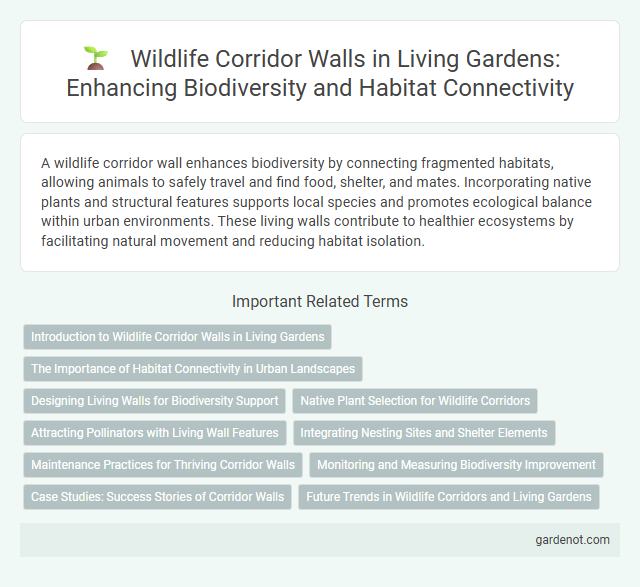A wildlife corridor wall enhances biodiversity by connecting fragmented habitats, allowing animals to safely travel and find food, shelter, and mates. Incorporating native plants and structural features supports local species and promotes ecological balance within urban environments. These living walls contribute to healthier ecosystems by facilitating natural movement and reducing habitat isolation.
Introduction to Wildlife Corridor Walls in Living Gardens
Wildlife corridor walls in living gardens serve as vital passageways that connect fragmented habitats, allowing animals and insects to safely traverse urban environments. These green structures enhance biodiversity by providing shelter, food sources, and nesting sites integrated directly into garden spaces. Incorporating native plants into wildlife corridor walls promotes ecological balance and supports local species migration and survival.
The Importance of Habitat Connectivity in Urban Landscapes
Wildlife corridor walls play a crucial role in enhancing habitat connectivity within urban landscapes by providing safe passage for animals between fragmented green spaces. These living walls support biodiversity and promote ecological balance by facilitating gene flow and reducing roadkill incidents. Integrating habitat connectivity into urban planning helps sustain diverse wildlife populations and strengthens ecosystem resilience.
Designing Living Walls for Biodiversity Support
Designing living walls as wildlife corridor walls enhances urban biodiversity by providing habitats and movement pathways for native species. Integrating diverse plant species with varying bloom times creates continuous food and shelter sources, supporting pollinators, birds, and small mammals. Using native vegetation and structural complexity in living wall designs fosters ecological connectivity and resilience within fragmented environments.
Native Plant Selection for Wildlife Corridors
Native plant selection for wildlife corridor walls enhances habitat connectivity by providing essential food and shelter for local species, supporting biodiversity and ecosystem health. Incorporating regionally adapted plants such as milkweed, goldenrod, and native grasses ensures resilience to local climate conditions and promotes pollinator populations like bees and butterflies. These plants facilitate safe wildlife movement by creating continuous green pathways that connect isolated habitats, aiding species migration and genetic diversity.
Attracting Pollinators with Living Wall Features
Living walls designed as wildlife corridors incorporate native flowering plants that attract essential pollinators such as bees, butterflies, and hummingbirds, enhancing urban biodiversity. These vertical ecosystems provide continuous foraging habitats, improving pollination rates for nearby gardens and green spaces. Integrating diverse plant species with staggered bloom periods ensures sustained nectar sources, supporting pollinator populations throughout the growing season.
Integrating Nesting Sites and Shelter Elements
Wildlife corridor walls that integrate nesting sites and shelter elements provide essential habitats for urban biodiversity, supporting bird, insect, and small mammal populations. These living walls create ecological networks that facilitate safe movement and breeding opportunities in fragmented environments. Incorporating varied plant species and structural features enhances shelter availability and promotes species diversity within urban ecosystems.
Maintenance Practices for Thriving Corridor Walls
Maintenance practices for thriving wildlife corridor walls include regular inspection to ensure plant health and structural integrity, timely removal of invasive species, and adequate irrigation tailored to native flora. Employing organic fertilizers and mulching supports soil vitality, while monitoring for pests promotes ecosystem balance. Consistent maintenance enhances habitat connectivity, fostering biodiversity and sustaining wildlife movement.
Monitoring and Measuring Biodiversity Improvement
Wildlife corridor walls enhance urban ecosystems by facilitating species movement and habitat connectivity. Monitoring biodiversity improvement involves using sensor technology, camera traps, and acoustic devices to track animal activity and species diversity. Data collected supports adaptive management strategies to increase ecological benefits and promote local wildlife populations.
Case Studies: Success Stories of Corridor Walls
Wildlife corridor walls serve as critical connectors that enable safe animal movement between fragmented habitats, demonstrated by successful case studies such as the Banff National Park overpass and the Wallis Annenberg Wildlife Crossing in California. These living wall installations utilize native vegetation to reduce habitat isolation and facilitate biodiversity by mimicking natural environments, promoting species migration and genetic diversity. Data from these projects show significant increases in wildlife crossings and reductions in roadkill, validating corridor walls as effective conservation tools.
Future Trends in Wildlife Corridors and Living Gardens
Wildlife corridor walls are evolving as essential green infrastructures that enhance biodiversity by connecting fragmented habitats and promoting species migration. Future trends include integrating smart technologies such as IoT sensors to monitor ecological health and using native plant species to create resilient living gardens that support pollinators and small mammals. Advances in vertical gardening and sustainable materials will further optimize habitat connectivity while improving urban air quality and ecological balance.
Wildlife corridor wall Infographic

 gardenot.com
gardenot.com